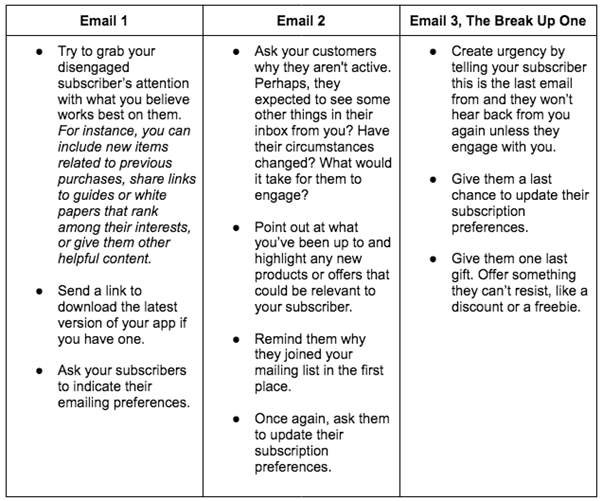Get Kim and Aggie in. They'll walk round your subscriber list, pulling faces. People are getting confused between MOPs and Mops. It's all a mess. So, what can you do about it?

One out of every five emails never makes it to the recipient's inbox. It might be blocked by the service provider, or go into the junk folder.
Bad deliverability leads to a bad reputation. And that just leads to even worse deliverability. It's a vicious cycle.
With a huge, unwieldy email list, you might find yourself in a difficult position. Though you might think: "Look at me, I've got all these subscribers, chomping at the bit to read my email, clicking refresh on their inbox to devour it the second it comes through", but this might only be the case for a percentage of your list.
For every interactive super-fan email address, you might have one that's unresponsive or even fake. And remember, with an unorganised list you might find that:
- You can't personalise emails due to lack of info
- Your leads and customers aren't very well organised in the list
- You get complaints from sales about false data
- ROI isn't is as high as you'd expect it to be
- Your conversion rates remain low - an undeliverable email can never convert
Personalised emails generate 6 times as many transactions than generic ones. And you can't personalise emails without clean and accurate data.
So, you've got to review your list every so often to remove any emails that bounce, that are unengaged, or have been changed and updated. It might even work in your favour to send a 'U Up?' message to your subscribers, to see if they're still on board with receiving emails from you. Let them weed themselves out, so to speak.
So, what else can help you keep that email list squeaky clean?
Keep Subscriber Info Top-Notch
This information can be highly valuable. Any email is a potential converted lead or sale. But sometimes, these emails are useless. The most important thing is to have correct, accurate and up-to-date information about your subscribers at your fingertips, so you'll have better success during the lifecycle of the recipient's engagement.
On a similar vein is bounce data - stop sending emails that bounce right back. Keep subscriber info updated, and avoid these bad characters. Most systems automatically remove bounces after two tries, but in some cases invalid emails are harder to identify.
You might need to use an email API to give you a hand, and to show which emails are likely to become hard bounces. You can then keep a closer eye on them, and remove them when the time comes.
Unsubscribers, too, are something you should pay attention to. Sending emails to someone who has opted out is a bad look. Not only does it keep your list clear of unresponsive people, but spamming someone with emails when they've asked not to be can damage your reputation.
Many email service providers do this automatically for you, but some people might unsubscribe using an email instead of the link, so stay vigilant.
Removing role accounts might be a good step, too. Role accounts are emails representing a group or alias, e.g. @Support @Hello or @info. They don't represent individuals and are not often checked. They also lack the personalisation that makes email marketing succeed. The person in charge of these inboxes can also change, too.
Whoever steps into the new role might even pop your newsletter down as spam. So, it's better to remove these, or seek out the business email of the person who signed up.
Make Sure your Leads, Well, Lead Somewhere
Go through each lead and make sure it's a good fit for your business before you add it to a list. You might get so caught up making sure your business is right for your clients, that you don't consider whether you have healthy and interested subscribers. Make sure the lead is added to the correct list, and entered correctly.
When you have active and engaged leads, your email service provider will respond well. The metrics they use to determine inbox placement can rely on things like this.
So, keep your email list warm, and their engagement high. If your email list is growing, but still freezing cold, you won't achieve the results you're looking for, and you may even get into your email service provider's bad books.
In fact, it might even get you black-listed.
Let Subscribers 'Opt-in'
If you follow this as a first step, you'll save yourself a lot of bother. Obtaining potential clients' permission first up ensures your list is filled with people who want to be there. It also means you skip those fake email addresses that might've been put in to get a free trial. Sorry Netflix.
There's a few ways to confirm email addresses upon sign up.
A double opt-in method is a good way of making sure the subscriber really does want to receive your content. This is how the process works:
- The subscriber enters their email on the sign up form
- Then, they have to follow a link to finish registration through the confirmation email.
Okay, that was a lot less complicated than the use of bullet points would suggest. But there you go, easy as.

Double opt-in might mean a little more work on the subscriber's part, but in the end the extra steps are good for both you and them. it's a win-win.
Use Data Checkers
This one is simple - use data checkers at the point of data collection to avoid adding bad emails to your list. By doing this, only properly formatted email addresses will be accepted into your contact database.
Data checkers can make sure that the email entered is properly formatted before it's accepted into your precious, precious database. By identifying errors at this point, you'll be able to prevent mistakes before they happen.
Make Sure your List is Spam Free
If an email hasn't seen any engagement within the last 180 days, you should probably call it quits. Remove it from your list, or even target it for a re-engagement campaign.
"Blacklist operators create spam traps with email addresses that have gone dormant.
While this helps catch spammers, it can also result in you becoming blacklisted if you continue to bombard such an inbox with messages," says Business2Community.com's Sophia Jacobson.
"Monitor your email lists and recipient engagement to avoid this."
Remove the Unengaged Subscribers

Try not to feel the sting of rejection in this one. But you've got to get rid of the subscribers not giving you the attention you deserve, girlfriend.
An unsubscribe link is required by law, but some people might not even get round to clicking that little button. So, if a few months goes by, and they haven't opened any of your emails, it's time to cut that cord. But don't do this before sending a "this is your final email" email. This could help retain a few customers through a 'last chance' incentive.
"While pruning an email list may statistically result in higher deliverability rates and customer engagement, you’ll want to give this careful consideration. These were, after all, previously active customers!", says Stirista.
Make sure you don't do this too often, though. Though it does give clients a chance to stay on an email list they were previously interested enough in to sign up for, they might just not have the time at the moment. But they definitely will get annoyed with the bombardment of "please don't ignore me" messages sent.
Also, consider why these previously interested individuals have lost interest. This may be because you are:
- Not sending out enough emails
- Not providing value for your subscribers
- Not standing out among the waves of emails in their inbox
- Missing the mark with your content
But like Stirista said, these used to be engaged customers. Old friends. So, consider sending a re-engagement email or offer to bring them back on board.
In fact, 45% of subscribers who receive a win-back email actually take interest in reading the messages from the brand.
There tends to be three different types of re-engagement email, in chronological order, put into a handy graph here by Nethunt:
Avoid the Spam Filter

This is a good one. Once everything's ship-shape, and your subscribers have opted-in you might:
Use a personalised address. Experian reports that personalized promotional emails have 29% higher unique open rates and 41 percent more unique click-through rates. So, include their name instead of the generic "Hi!" or "Hey There!". Remember - one way your subscribers identify spam is by how they're addressed.
…and consider your subject line. People do judge a book by it's cover, despite constantly being told not to. I mean, I only read Metamorphosis because of the giant bug on the front. A subscriber might deem your email 'not worth their time' if it's filled with spelling errors, or exclamation points, or all caps. But it might not even get to that point - the spam filter is likely to pick it up first.
The CAN-SPAM Act (different from Canned Spam) became law on January 1st, 2004. Violation of the law can lead to $11,000 fines for each offence. Now, that's $11,000 for every email sent. Ouch. If you send commercial emails, however, you should familiarise yourself with the law.
Key, important points include:
- Never use deceptive headers, From names, reply-to addresses, or subject lines.
- Always provide an unsubscribe link.
- The unsubscribe link must work for at least 30 days after sending.
- You must include your physical mailing address.
Consider whether you need to build, or buy.
Purchased email lists are notorious for bad hygiene. Plus, they can lead to a big old spike in spam complaints, or hide a spam trap.
This is an email address used by Internet Service Providers and blocklist operators to identify senders who aren't following email best practises. Spam traps can even slash deliverability rates down from 98% to 25%.
So, unless speed is a massive priority, always consider building your mailing list.
It may be convenient to buy an email list, but it won't be nearly as impactful as building your own. Think a burger bun chucked out behind a McDonald's vs a loaf of home-made Bloomer.
Plus, there are many shady sources who will sell you lists with hundreds of thousands of poor quality contacts, who might be unresponsive or even annoyed at your emails.
Plus, buying an email list can also mean:
- There's a chance your competitors are buying the same email list
- You'll be sent a bunch of spam trap emails, meaning that when you send content to these contacts, your sender's address and IP address will be blacklisted as spam
- Contacts, who don't wish to be contacted, might mark you as spam. With enough complaints, the email service provider will terminate your account.
- A GDPR violation. The emails on your mailing list haven't opted in, so you risk fines and penalties.

